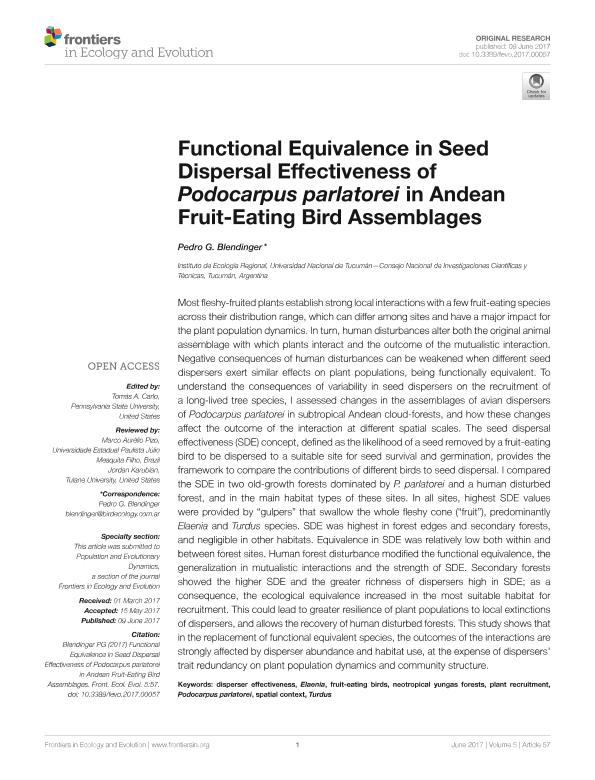Mostrar el registro sencillo del ítem
dc.contributor.author
Blendinger, Pedro Gerardo

dc.date.available
2018-11-22T17:55:16Z
dc.date.issued
2017-06-09
dc.identifier.citation
Blendinger, Pedro Gerardo; Functional equivalence in seed dispersal effectiveness of Podocarpus parlatorei in Andean frui -eating bird assemblages; Frontiers Media S. A; Frontiers in Ecology and Evolution; 5; JUN; 9-6-2017; 1-14
dc.identifier.issn
2296-701X
dc.identifier.uri
http://hdl.handle.net/11336/64935
dc.description.abstract
Most fleshy-fruited plants establish strong local interactions with a few fruit-eating species across their distribution range, which can differ among sites and have a major impact for the plant population dynamics. In turn, human disturbances alter both the original animal assemblage with which plants interact and the outcome of the mutualistic interaction. Negative consequences of human disturbances can be weakened when different seed dispersers exert similar effects on plant populations, being functionally equivalent. To understand the consequences of variability in seed dispersers on the recruitment of a long-lived tree species, I assessed changes in the assemblages of avian dispersers of Podocarpus parlatorei in subtropical Andean cloud-forests, and how these changes affect the outcome of the interaction at different spatial scales. The seed dispersal effectiveness (SDE) concept, defined as the likelihood of a seed removed by a fruit-eating bird to be dispersed to a suitable site for seed survival and germination, provides the framework to compare the contributions of different birds to seed dispersal. I compared the SDE in two old-growth forests dominated by P. parlatorei and a human disturbed forest, and in the main habitat types of these sites. In all sites, highest SDE values were provided by "gulpers" that swallow the whole fleshy cone ("fruit"), predominantly Elaenia and Turdus species. SDE was highest in forest edges and secondary forests, and negligible in other habitats. Equivalence in SDE was relatively low both within and between forest sites. Human forest disturbance modified the functional equivalence, the generalization in mutualistic interactions and the strength of SDE. Secondary forests showed the higher SDE and the greater richness of dispersers high in SDE; as a consequence, the ecological equivalence increased in the most suitable habitat for recruitment. This could lead to greater resilience of plant populations to local extinctions of dispersers, and allows the recovery of human disturbed forests. This study shows that in the replacement of functional equivalent species, the outcomes of the interactions are strongly affected by disperser abundance and habitat use, at the expense of dispersers' trait redundancy on plant population dynamics and community structure.
dc.format
application/pdf
dc.language.iso
eng
dc.publisher
Frontiers Media S. A
dc.rights
info:eu-repo/semantics/openAccess
dc.rights.uri
https://creativecommons.org/licenses/by-nc-sa/2.5/ar/
dc.subject
Disperser Effectiveness
dc.subject
Elaenia
dc.subject
Fruit-Eating Birds
dc.subject
Neotropical Yungas Forests
dc.subject
Plant Recruitment
dc.subject
Podocarpus Parlatorei
dc.subject
Spatial Context
dc.subject
Turdus
dc.subject.classification
Otras Ciencias Biológicas

dc.subject.classification
Ciencias Biológicas

dc.subject.classification
CIENCIAS NATURALES Y EXACTAS

dc.title
Functional equivalence in seed dispersal effectiveness of Podocarpus parlatorei in Andean frui -eating bird assemblages
dc.type
info:eu-repo/semantics/article
dc.type
info:ar-repo/semantics/artículo
dc.type
info:eu-repo/semantics/publishedVersion
dc.date.updated
2018-10-23T20:38:10Z
dc.journal.volume
5
dc.journal.number
JUN
dc.journal.pagination
1-14
dc.journal.pais
Suiza

dc.description.fil
Fil: Blendinger, Pedro Gerardo. Universidad Nacional de Tucumán. Instituto de Ecología Regional. Consejo Nacional de Investigaciones Científicas y Técnicas. Centro Científico Tecnológico Conicet - Tucumán. Instituto de Ecología Regional; Argentina
dc.journal.title
Frontiers in Ecology and Evolution
dc.relation.alternativeid
info:eu-repo/semantics/altIdentifier/url/http://journal.frontiersin.org/article/10.3389/fevo.2017.00057
dc.relation.alternativeid
info:eu-repo/semantics/altIdentifier/doi/https://dx.doi.org/10.3389/fevo.2017.00057
Archivos asociados
